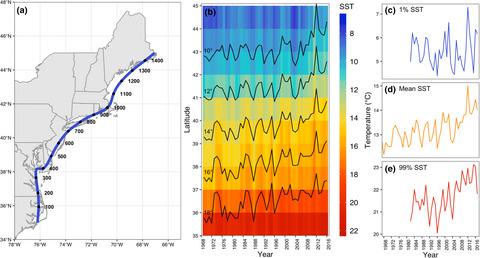当前位置:
X-MOL 学术
›
Glob. Change Biol.
›
论文详情
Our official English website, www.x-mol.net, welcomes your
feedback! (Note: you will need to create a separate account there.)
Cold range edges of marine fishes track climate change better than warm edges.
Global Change Biology ( IF 10.8 ) Pub Date : 2020-03-12 , DOI: 10.1111/gcb.15035 Alexa Fredston-Hermann 1 , Rebecca Selden 2 , Malin Pinsky 3 , Steven D Gaines 1 , Benjamin S Halpern 1, 4
Global Change Biology ( IF 10.8 ) Pub Date : 2020-03-12 , DOI: 10.1111/gcb.15035 Alexa Fredston-Hermann 1 , Rebecca Selden 2 , Malin Pinsky 3 , Steven D Gaines 1 , Benjamin S Halpern 1, 4
Affiliation

|
Species around the world are shifting their ranges in response to climate change. To make robust predictions about climate-related colonizations and extinctions, it is vital to understand the dynamics of range edges. This study is among the first to examine annual dynamics of cold and warm range edges, as most global change studies average observational data over space or over time. We analyzed annual range edge dynamics of marine fishes-both at the individual species level and pooled into cold- and warm-edge assemblages-in a multi-decade time-series of trawl surveys conducted on the Northeast U.S. Shelf during a period of rapid warming. We tested whether cold edges show stronger evidence of climate tracking than warm edges (due to non-climate processes or time lags at the warm edge; the biogeography hypothesis or extinction debt hypothesis), or whether they tracked temperature change equally (due to the influence of habitat suitability; the ecophysiology hypothesis). In addition to exploring correlations with regional temperature change, we calculated species- and assemblage-specific sea bottom and sea surface temperature isotherms and used them to predict range edge position. Cold edges shifted further and tracked sea surface and bottom temperature isotherms to a greater degree than warm edges. Mixed-effects models revealed that for a one-degree latitude shift in isotherm position, cold edges shifted 0.47 degrees of latitude, and warm edges shifted only 0.28 degrees. Our results suggest that cold range edges are tracking climate change better than warm range edges, invalidating the ecophysiology hypothesis. We also found that even among highly mobile marine ectotherms in a global warming hotspot, few species are fully keeping pace with climate.
中文翻译:

海洋鱼类的寒冷范围边缘比温暖边缘更好地跟踪气候变化。
世界各地的物种正在响应气候变化而改变其范围。为了对气候相关的殖民化和灭绝做出可靠的预测,了解范围边缘的动态至关重要。这项研究是最早检查冷,暖范围边缘的年度动态的研究之一,因为大多数全球变化研究对空间或时间上的观测数据进行平均。我们在快速变暖时期对美国东北部陆架进行了数十年的拖网调查,分析了海洋鱼类在单个物种级别上的年度范围边缘动态,并将它们合并为冷缘和暖缘组合。我们测试了冷边缘是否比暖边缘显示出更强的气候追踪证据(由于非气候过程或暖边缘的时间滞后;生物地理学假设或灭绝债务假设),或他们是否均等地跟踪温度变化(由于栖息地适宜性的影响;生态生理学假设)。除了探索与区域温度变化的相关性之外,我们还计算了特定于物种和组合的海底和海面温度等温线,并将其用于预测范围边缘位置。冷边缘比暖边缘进一步移动并跟踪海面和底部温度等温线。混合效应模型显示,等温线位置发生一度纬度偏移时,冷边缘会偏移0.47度纬度,而暖边缘仅偏移0.28度。我们的结果表明,与温暖范围边缘相比,寒冷范围边缘对气候变化的跟踪更好,从而使生态生理学假设无效。
更新日期:2020-04-22
中文翻译:

海洋鱼类的寒冷范围边缘比温暖边缘更好地跟踪气候变化。
世界各地的物种正在响应气候变化而改变其范围。为了对气候相关的殖民化和灭绝做出可靠的预测,了解范围边缘的动态至关重要。这项研究是最早检查冷,暖范围边缘的年度动态的研究之一,因为大多数全球变化研究对空间或时间上的观测数据进行平均。我们在快速变暖时期对美国东北部陆架进行了数十年的拖网调查,分析了海洋鱼类在单个物种级别上的年度范围边缘动态,并将它们合并为冷缘和暖缘组合。我们测试了冷边缘是否比暖边缘显示出更强的气候追踪证据(由于非气候过程或暖边缘的时间滞后;生物地理学假设或灭绝债务假设),或他们是否均等地跟踪温度变化(由于栖息地适宜性的影响;生态生理学假设)。除了探索与区域温度变化的相关性之外,我们还计算了特定于物种和组合的海底和海面温度等温线,并将其用于预测范围边缘位置。冷边缘比暖边缘进一步移动并跟踪海面和底部温度等温线。混合效应模型显示,等温线位置发生一度纬度偏移时,冷边缘会偏移0.47度纬度,而暖边缘仅偏移0.28度。我们的结果表明,与温暖范围边缘相比,寒冷范围边缘对气候变化的跟踪更好,从而使生态生理学假设无效。











































 京公网安备 11010802027423号
京公网安备 11010802027423号